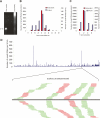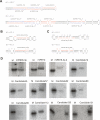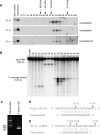A complex system of small RNAs in the unicellular green alga Chlamydomonas reinhardtii
- PMID: 17470535
- PMCID: PMC1865491
- DOI: 10.1101/gad.1543507
A complex system of small RNAs in the unicellular green alga Chlamydomonas reinhardtii
Abstract
Endogenous small RNAs function in RNA interference (RNAi) pathways to control gene expression through mRNA cleavage, translational repression, or chromatin modification. Plants and animals contain many microRNAs (miRNAs) that play vital roles in development, including helping to specify cell type and tissue identity. To date, no miRNAs have been reported in unicellular organisms. Here we show that Chlamydomonas reinhardtii, a unicellular green alga, encodes many miRNAs. We also show that a Chlamydomonas miRNA can direct the cleavage of its target mRNA in vivo and in vitro. We further show that the expression of some miRNAs/Candidates increases or decreases during Chlamydomonas gametogenesis. In addition to miRNAs, Chlamydomonas harbors other types of small RNAs including phased small interfering RNAs (siRNAs) that are reminiscent of plant trans-acting siRNAs, as well as siRNAs originating from protein-coding genes and transposons. Our findings suggest that the miRNA pathway and some siRNA pathways are ancient mechanisms of gene regulation that evolved prior to the emergence of multicellularity.
Figures





Comment in
-
Expanding RNA physiology: microRNAs in a unicellular organism.Genes Dev. 2007 May 15;21(10):1153-6. doi: 10.1101/gad.1559707. Genes Dev. 2007. PMID: 17504934 Review. No abstract available.
Similar articles
-
Complementarity to an miRNA seed region is sufficient to induce moderate repression of a target transcript in the unicellular green alga Chlamydomonas reinhardtii.Plant J. 2013 Dec;76(6):1045-56. doi: 10.1111/tpj.12354. Plant J. 2013. PMID: 24127635
-
miRNAs control gene expression in the single-cell alga Chlamydomonas reinhardtii.Nature. 2007 Jun 28;447(7148):1126-9. doi: 10.1038/nature05903. Epub 2007 May 30. Nature. 2007. PMID: 17538623
-
Identification of AGO3-associated miRNAs and computational prediction of their targets in the green alga Chlamydomonas reinhardtii.Genetics. 2015 May;200(1):105-21. doi: 10.1534/genetics.115.174797. Epub 2015 Mar 13. Genetics. 2015. PMID: 25769981 Free PMC article.
-
Expanding RNA physiology: microRNAs in a unicellular organism.Genes Dev. 2007 May 15;21(10):1153-6. doi: 10.1101/gad.1559707. Genes Dev. 2007. PMID: 17504934 Review. No abstract available.
-
miRNAs in the biogenesis of trans-acting siRNAs in higher plants.Semin Cell Dev Biol. 2010 Oct;21(8):798-804. doi: 10.1016/j.semcdb.2010.03.008. Epub 2010 Mar 30. Semin Cell Dev Biol. 2010. PMID: 20359543 Review.
Cited by
-
The effects of MicroRNA transfections on global patterns of gene expression in ovarian cancer cells are functionally coordinated.BMC Med Genomics. 2012 Aug 1;5:33. doi: 10.1186/1755-8794-5-33. BMC Med Genomics. 2012. PMID: 22853714 Free PMC article.
-
Comprehensive analysis of microRNA-Seq and target mRNAs of rice sheath blight pathogen provides new insights into pathogenic regulatory mechanisms.DNA Res. 2016 Oct 1;23(5):415-425. doi: 10.1093/dnares/dsw024. DNA Res. 2016. PMID: 27374612 Free PMC article.
-
Transcriptome-wide analysis of small RNA expression in early zebrafish development.RNA. 2012 May;18(5):915-29. doi: 10.1261/rna.029090.111. Epub 2012 Mar 8. RNA. 2012. PMID: 22408181 Free PMC article.
-
Characterization and differential expression of microRNAs elicited by sulfur deprivation in Chlamydomonas reinhardtii.BMC Genomics. 2012 Mar 22;13:108. doi: 10.1186/1471-2164-13-108. BMC Genomics. 2012. PMID: 22439676 Free PMC article.
-
miRBase: tools for microRNA genomics.Nucleic Acids Res. 2008 Jan;36(Database issue):D154-8. doi: 10.1093/nar/gkm952. Epub 2007 Nov 8. Nucleic Acids Res. 2008. PMID: 17991681 Free PMC article.
References
-
- Allen E., Xie Z., Gustafson A.M., Sung G.H., Spatafora J.W., Carrington J.C., Xie Z., Gustafson A.M., Sung G.H., Spatafora J.W., Carrington J.C., Gustafson A.M., Sung G.H., Spatafora J.W., Carrington J.C., Sung G.H., Spatafora J.W., Carrington J.C., Spatafora J.W., Carrington J.C., Carrington J.C. Evolution of microRNA genes by inverted duplication of target gene sequences in Arabidopsis thaliana. Nat. Genet. 2004;36:1282–1290. - PubMed
-
- Allen E., Xie Z., Gustafson A.M., Carrington J.C., Xie Z., Gustafson A.M., Carrington J.C., Gustafson A.M., Carrington J.C., Carrington J.C. microRNA-directed phasing during trans-acting siRNA biogenesis in plants. Cell. 2005;121:207–221. - PubMed
-
- Aravin A.A., Lagos-Quintana M., Yalcin A., Zavolan M., Marks D., Snyder B., Gaasterland T., Meyer J., Tuschl T., Lagos-Quintana M., Yalcin A., Zavolan M., Marks D., Snyder B., Gaasterland T., Meyer J., Tuschl T., Yalcin A., Zavolan M., Marks D., Snyder B., Gaasterland T., Meyer J., Tuschl T., Zavolan M., Marks D., Snyder B., Gaasterland T., Meyer J., Tuschl T., Marks D., Snyder B., Gaasterland T., Meyer J., Tuschl T., Snyder B., Gaasterland T., Meyer J., Tuschl T., Gaasterland T., Meyer J., Tuschl T., Meyer J., Tuschl T., Tuschl T. The small RNA profile during Drosophila melanogasterdevelopment. Dev. Cell. 2003;5:337–350. - PubMed
-
- Aravin A., Gaidatzis D., Pfeffer S., Lagos-Quintana M., Landgraf P., Iovino N., Morris P., Brownstein M.J., Kuramochi-Miyagawa S., Nakano T., Gaidatzis D., Pfeffer S., Lagos-Quintana M., Landgraf P., Iovino N., Morris P., Brownstein M.J., Kuramochi-Miyagawa S., Nakano T., Pfeffer S., Lagos-Quintana M., Landgraf P., Iovino N., Morris P., Brownstein M.J., Kuramochi-Miyagawa S., Nakano T., Lagos-Quintana M., Landgraf P., Iovino N., Morris P., Brownstein M.J., Kuramochi-Miyagawa S., Nakano T., Landgraf P., Iovino N., Morris P., Brownstein M.J., Kuramochi-Miyagawa S., Nakano T., Iovino N., Morris P., Brownstein M.J., Kuramochi-Miyagawa S., Nakano T., Morris P., Brownstein M.J., Kuramochi-Miyagawa S., Nakano T., Brownstein M.J., Kuramochi-Miyagawa S., Nakano T., Kuramochi-Miyagawa S., Nakano T., Nakano T., et al. A novel class of small RNAs bind to MILI protein in mouse testes. Nature. 2006;442:203–207. - PubMed
Publication types
MeSH terms
Substances
LinkOut - more resources
Full Text Sources
Other Literature Sources
Molecular Biology Databases
